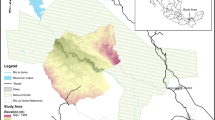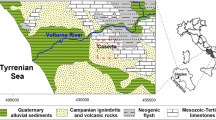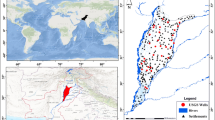Abstract
A simplified methodology for mapping groundwater vulnerability and contamination risk is proposed, and the first application of the methodology, in a mountainous tropical karst area, is presented. The test site is the Tam Duong area, one of the poorest and remotest regions in northern Vietnam. The methodology requires a minimum of input data, which makes it particularly useful for developing countries. Vulnerability is assessed on the basis of two factors, which take into account the duality of recharge processes in karst aquifer systems: the overlying layers (O) and the concentration of flow (C). The risk map is obtained by putting together the vulnerability map and a simplified hazard assessment. The resulting maps provide a basis for groundwater protection zoning and land-use planning. Tracer tests and microbiological data confirmed the vulnerability and risk assessment in the test site.
Résumé
Une méthodologie simplifiée de cartographie de la vulnérabilité des eaux souterraines et du risque de contamination est proposée. Une première application est présentée, dans une zone karstique montagneuse sous climat tropical. Le site expérimental choisi est le secteur de Tam Duong, une des régions les plus pauvres et les plus isolées du Nord Vietnam. Cette approche ne nécessite qu’une quantité minimale de données d’entrée, ce qui en fait un outil utile pour les pays en voie de développement. L’appréciation de la vulnérabilité est basée sur deux facteurs prenant en compte la dualité des processus de recharge des systèmes karstiques: les couches supérieures (“overlying layers”, facteur O), et la concentration des flux d’infiltration (“concentration of flow”, facteur C). Le recoupement de la carte de vulnérabilité avec l’estimation simplifiée des aléas permet d’établir la carte des risques. Les cartes résultantes fournissent une base pour le zonage de la protection des eaux souterraines et l’aménagement de l’espace. Traçages et données microbiologiques ont confirmé les évaluations de la vulnérabilité et des risques effectuées sur le site expérimental.
Resumen
Se propone una metodología simplificada para realizar la cartografía de la vulnerabilidad de agua subterránea y el riesgo a la contaminación y se presenta la primera aplicación de la metodología en un área kárstica tropical montañosa. El sitio evaluado es el área Tam Duong, una de las regiones más pobres y remotas del norte de Vietnam. La metodología requiere un mínimo de datos de entrada lo que la hace particularmente útil para países en desarrollo. La vulnerabilidad se evalúa en base a dos factores los cuales toman en cuenta la dualidad de los procesos de recarga en sistemas de acuíferos kársticos: las capas sobreyacientes (O) y la concentración de flujo (C). El mapa de riesgo se obtiene mediante la integración del mapa de vulnerabilidad y una evaluación simplificada de la amenaza. Los mapas producidos de esta manera aportan bases para la zonificación de la protección de aguas subterráneas y la planificación del uso de la tierra. Pruebas con trazadores y datos microbiológicos confirman la vulnerabilidad y la evaluación de riesgos en el sitio experimental.





Similar content being viewed by others

References
Adams B, Foster SSD (1992) Land-surface zoning for groundwater protection. J Inst Water Environ Manage 6(3):312–320
Andreo B, Goldscheider N, Vadillo I, Vías JM, Neukum C, Sinreich M, Jiménez P, Brechenmacher J, Carrasco F, Hötzl H, Perles MJ, Zwahlen F (2006) Karst groundwater protection: first application of a Pan-European approach to vulnerability, hazard and risk mapping in the Sierra de Líbar, southern Spain. Sci Total Environ 357(1–3):54–73
Bakalowicz M (2005) Karst groundwater: a challenge for new resources. Hydrogeol J 13(1):148–160
Brouyère S (2004) A quantitative point of view of the concept of vulnerability. In: Zwahlen F (ed) Vulnerability and risk mapping for the protection of carbonate (karst) aquifers, final report COST Action 620. European Commission Directorate-General for Research, EUR 2091:10–15
Daly D, Dassargues A, Drew D, Dunne S, Goldscheider N, Neale S, Popescu IC, Zwahlen F (2002) Main concepts of the european approach for (karst) groundwater vulnerability assessment and mapping. Hydrogeol J 10:340–345
De Ketelaere D, Hötzl H, Neukum C, Civita M, Sappa G (2004) Hazard analysis and mapping. In: Zwahlen F (ed) Vulnerability and risk mapping for the protection of carbonate (karst) aquifers, final report COST Action 620. European Commission, Directorate-General for Research, EUR 20912:86–105
DoELG/EPA/GSI (1999) Groundwater protection schemes. Department of Environment and Local Government, Environmental Protection Agency and Geological Survey of Ireland, Dublin, p 24
Doerfliger N, Zwahlen F (1998) Practical guide: groundwater vulnerability mapping in karstic regions (EPIK). Swiss Agency for the Environment Forests and Landscape (SAEFL), Bern, p 56
Drew D, Hötzl H (eds) (1999) Karst hydrogeology and human activities: impacts, consequences and implications. Int Contrib Hydrogeol 20:20
Ford DC, Williams PW (1989) Karst geomorphology and hydrology. Chapman & Hall, London
Foster SSD (1987) Fundamental concepts in aquifer vulnerability, pollution risk and protection strategy. In: Van Duijevenboden W, Van Waegeningh HG (eds) Vulnerability of soil and groundwater to pollutants, TNO Committee on Hydrogeological Research, Proc Info 38:69–86
Foster SSD, Chilton PJ (2003) Groundwater: the processes and global significance of aquifer degradation. Philos Trans R Soc Lond B Biol Sci 358(1440):1957–1972
Gogu RC, Dassargues A (2000) Current trends and future challenges in groundwater vulnerability assessment using overly and index methods. Environ Geol 39(6):549–559
Gogu RC, Hallet V, Dassargues A (2003) Comparison of aquifer vulnerability assessment techniques. Application to the Neblon River basin (Belgium). Environ Geol 44(8):881–892
Goldscheider N (2004) The concept of groundwater vulnerability. In: Zwahlen F (ed) Vulnerability and risk mapping for the protection of carbonate (karst) aquifers, final report COST Action 620. European Commission, Directorate-General for Research, EUR 20912:5–9
Goldscheider N (2005a) Fold structure and underground drainage pattern in the alpine karst system Hochifen-Gottesacker. Eclogae Geol Helv 98:1–17
Goldscheider N (2005b) Karst groundwater vulnerability mapping: application of a new method in the Swabian Alb, Germany. Hydrogeol J 13:555–564
Goldscheider N, Popescu IC (2004) The European approach. In: Zwahlen F (ed) Vulnerability and risk mapping for the protection of carbonate (karst) aquifers, final report COST Action 620. European Commission Directorate-General for Research, EUR 20912:17–21
Goldscheider N, Klute M, Sturm S, Hötzl H (2000) The PI method, a GIS-based approach to mapping groundwater vulnerability with special consideration of karst aquifers. Z Angew Geol 46:157–166
Goldscheider N, Hötzl H, Fries W, Jordan P (2001) Validation of a vulnerability map (EPIK) with tracer tests: 7th conference on limestone hydrology and fissured Media. Besançon 20–22:167–170
Holman IP, Palmer RC, Bellamy PH, Hollis JM (2005) Validation of an intrinsic groundwater pollution vulnerability methodology using a national nitrate database. Hydrogeol J 13(5–6):665–674
Hötzl H, Delporte C, Liesch T, Malik P, Neukum C, Svasta J (2004) Risk mapping. In: Zwahlen F (ed) Vulnerability and risk mapping for the protection of carbonate (karst) aquifers, final report COST Action 620, European Commission Directorate-General for Research, EUR 20912:113–120
Loop CM, White WB (2001) A conceptual model for DNAPL transport in karst ground water basins. Ground Water 39(1):119–127
Margat J (1968) Vulnérabilité des nappes d’eau souterraine à la pollution (vulnerability of groundwater to pollution). BRGM-Publication 68 SGL 198 HYD, Orléans
My BP (1978) Geological map of Vietnam 1:200.000, Lao Cai-Kim Binh. Geological Survey of Vietnam
Nguyet VTM, Goldscheider N (2006) Tracer tests, hydrochemical and microbiological investigations as a basis for groundwater protection in a remote tropical mountainous karst area, Vietnam. Hydrogeol J (in press). DOI 10.1007/s10040-006-0038-z
NRC-National Research Council (1997) Valuing groundwater: economic concepts and approaches. National Academic Press, Washington, DC, p 189
Perrin J, Pochon A, Jeannin PY, Zwahlen F (2004) Vulnerability assessment in karstic areas: validation by field experiments. Environ Geol 46(2):237–245
Sinreich S, Kozel R, Mudry J (2004) Specific vulnerability method. In: Zwahlen F (ed) Vulnerability and risk mapping for the protection of carbonate (karst) aquifers, final report COST Action 620 European Commission Directorate-General for Research, EUR 20912, pp 67–83
Thu T, Ban NV (1996) Geology and mineral deposits of the Phong Tho sheet. Intergeo, Hanoi
Tuyet D (1998) Karst geology investigation of the northwest region. Research Institute of Geology and Mineral Resources, Hanoi, p 251
Vias JM, Andreo B, Perles MJ, Carrasco F (2005) A comparative study of four schemes for groundwater vulnerability mapping in a diffuse flow carbonate aquifer under Mediterranean climatic conditions. Environ Geol 47(4):586–595
Vrba J, Zaporozec A (eds) (1994) Guidebook on mapping groundwater vulnerability. Int Contrib Hydrogeol 16:131
White WB (2002) Karst hydrology: recent developments and open questions. Eng Geol 65(2–3):85–105
WHO (2004) Guidelines for drinking-water quality, 3rd edn., vol 1, Recommendations, World Health Organisation, Geneva, p 515
Zwahlen F (ed) (2004) Vulnerability and risk mapping for the protection of carbonate (karst) aquifers, final report COST action 620. European Commission, Directorate-General for Research, EUR 20912:297
Acknowledgements
The Swiss Federal Commission for Foreign Students and the Belgian Technical Cooperation partially funded this study. We thank the RIGMR researchers for information and logistic support, and D. M. Cung and the people from Tam Duong for their help in the field. We are grateful to Prof. F. De Smedt and Dr. O. Batelaan (Free University of Brussels) and Prof. F. Zwahlen (CHYN) for their kind support, and D. Daly, M. Lee (GSI) and Prof. D. Drew (Trinity College Dublin) for valuable suggestions and corrections.
Author information
Authors and Affiliations
Corresponding author
Rights and permissions
About this article
Cite this article
Nguyet, V.T.M., Goldscheider, N. A simplified methodology for mapping groundwater vulnerability and contamination risk, and its first application in a tropical karst area, Vietnam. Hydrogeol J 14, 1666–1675 (2006). https://doi.org/10.1007/s10040-006-0069-5
Received:
Accepted:
Published:
Issue Date:
DOI: https://doi.org/10.1007/s10040-006-0069-5



